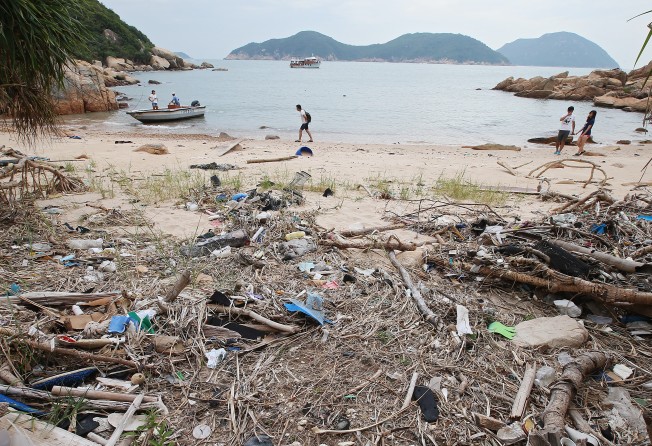
Trash from mainland China ending up on Hong Kong’s shores could be 7 times worse than estimated, green group warns
Earlier study concluded that less than 5 per cent of plastic waste on shorelines was from across border but The Green Earth believes figure could be 38 per cent

The amount of marine litter from mainland China washing up on Hong Kong’s shores could be seven times higher than government estimates, an environmental advocacy group said on Tuesday.
A 2015 study by the city’s Environmental Protection Department on marine rubbish concluded that less than 5 per cent of the trash washing up on local shorelines came from up north.
But new research by The Green Earth on Hong Kong’s shorelines last month suggested the figure could be as much as 38 per cent.

“Our results may only serve as a reference but from the huge discrepancy between our figures and the government’s, it’s clear the government may have severely underestimated the contribution of mainland rubbish in Hong Kong,” project officer Mandy Cheung Wing-man said.
Between April 2013 and March 2014, a government-led working group collected 15,000 tonnes of floating and shore-based marine refuse and found that less than 5 per cent – under 750 tonnes – came from the mainland and the rest was considered domestic.
The ratio of local to non-local trash was determined by looking at which waste items had labels with the simplified Chinese characters used on the mainland. More than 70 per cent of that trash was non-biodegradable plastic and foam. Hong Kong uses traditional Chinese characters.
But Cheung said the department’s methodology was probably not the most scientific way to measure shoreline rubbish given the city’s unique geographical position at the mouth of the Pearl River and the seasonal tidal flows, which flushed rubbish into Hong Kong waters.
“We’ve spoken to official and non-official sources, and they also agree there are loopholes in their methodology,” she said.
“They looked at simplified Chinese lettering on brand labels to distinguish between local and mainland but everything else [including trash without labels] was considered local.”
The Green Earth used the same method at 10 bays, coasts and inlets, including Shek O, Sai Kung, Sha Tau Kok and a number of outlying islands.
They collected 1,776 plastic bottles – one of the most common types of marine refuse – and found 678 (38 per cent) with simplified Chinese labelling, 967 (55 per cent) with traditional Chinese labelling and 131 (7 per cent) with other lettering.
Applying the 38 per cent ratio to the government’s 15,000 tonne haul would give 5,700 tonnes – the weight of about 356 double-decker buses and 7.6 times the original estimate.
The Green Earth executive director Edwin Lau Che-feng urged the governments of Hong Kong and neighbouring Guangdong province to strengthen regional cooperation in reducing waste at source and legislate producer responsibility schemes which require manufacturers to implement proper recycling.
A spokesman for the Environmental Protection Department said Green Earth only sampled a small sample size of plastic bottles and the results may not have accurately reflected the situation and the types of rubbish at sea at different seasons and locations.
The department also stressed there was “no objective way” to identify the percentage of non-local marine rubbish, nor their origins and that even its own results in 2015 were to only serve as a reference.
A government working group would continue tackling the problem using a “three-pronged strategy” of reducing overall waste generation at source, removing refuse that entered waters, and discouraging use of disposable items, it said.
A Hong Kong-Guangdong Marine Environmental Management Special Panel was also in place to facilitate cross-border cooperation on such matters.
“If a large amount of garbage is found to have flowed from the mainland to Hong Kong waters, Guangdong [environment authorities] will notify [Hong Kong authorities] via the notification mechanism established under the framework ... so that relevant departments can allocate resources to intercept the rubbish and conduct clean-up,” a spokesman said.